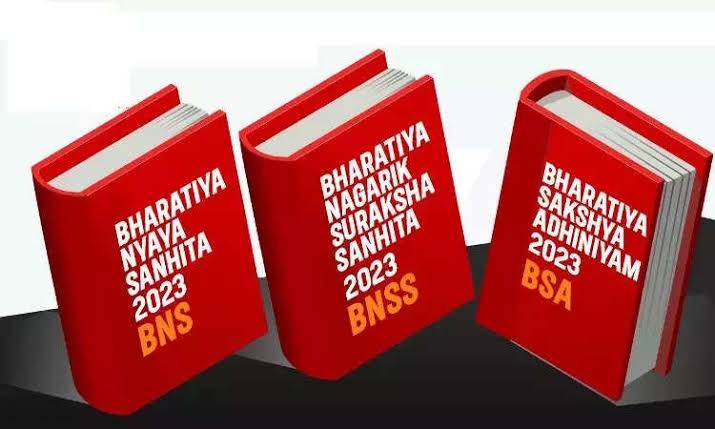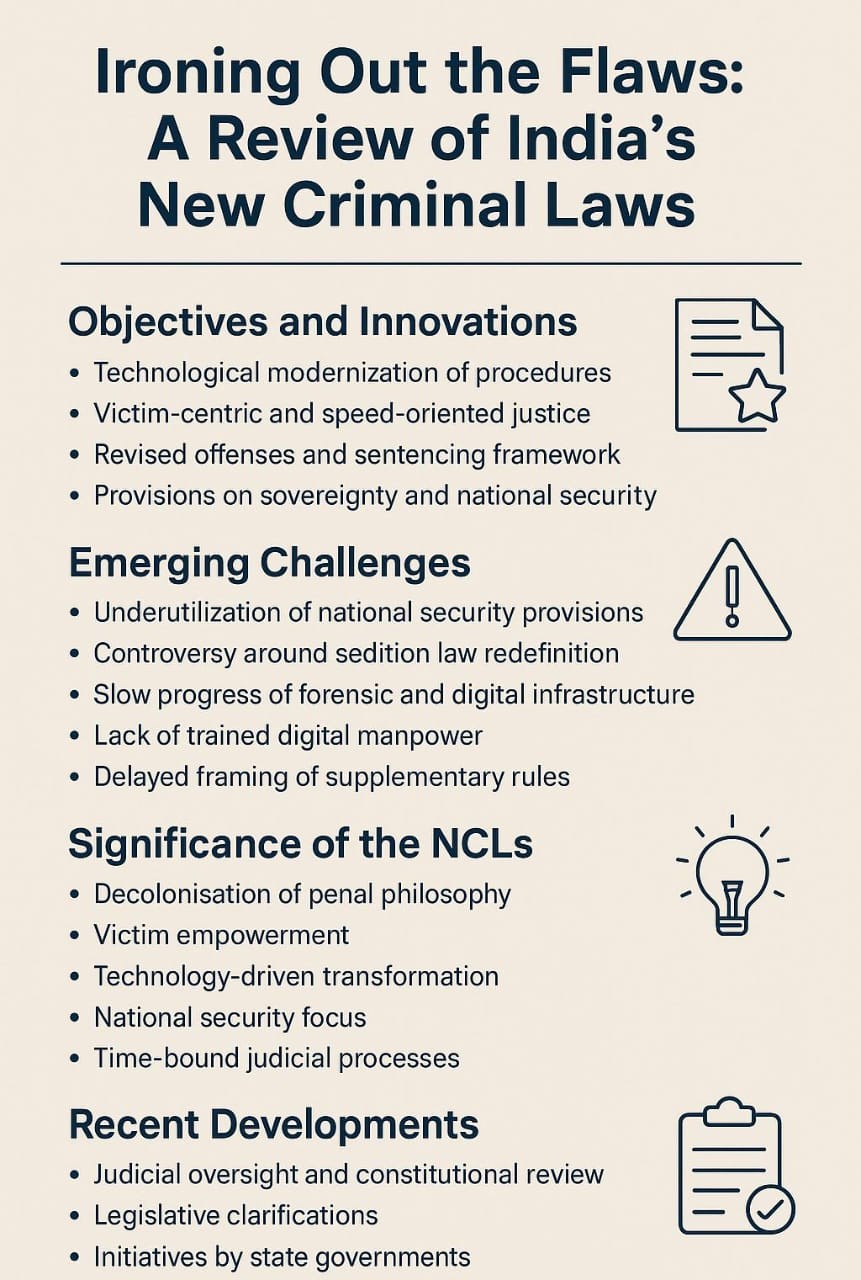Table of Contents
Context: On July 1, 2024, India enacted a significant reform in its criminal justice system by implementing three new statutes, namely, Bharatiya Nyaya Sanhita, 2023 (BNS), Bharatiya Nagarik Suraksha Sanhita, 2023 (BNSS), and Bharatiya Sakshya Adhiniyam, 2023 (BSA) which superseded the colonial-era Indian Penal Code, 1860, Criminal Procedure Code, 1973, and Indian Evidence Act, 1872. The New Criminal Laws (NCLs) together seek to transform the justice system from a deterrence-focused colonial paradigm to a victim-centred, expeditious, and technologically advanced framework.

Objectives and Key Innovations in the New Criminal Law
The NCLs are founded on three guiding principles: Nyaya (justice), Suraksha (security), and Nagarik (citizen empowerment). The principal improvements implemented comprise:
Technological Advancement
- Compulsory utilisation of forensic instruments in the examination of egregious or heinous offences.
- Implementation of digital FIRs, videographic documentation of search and seizure, and electronic summons to mitigate delays.
- Digitalisation of case records and inter-agency collaboration through digital platforms.
Victim-Centric and Speed-Oriented Justice
- Acknowledgement of victims’ rights to engage in prosecution and investigation.
- Focus on witness protection and victim compensation.
- Time constraints were established for concluding investigations (90 days), formulating charges (60 days), and issuing judgments (30 days post-trial conclusion).
C. Amended Substantive Offences
- Section 152 of the BNS has redefined sedition to emphasise actions that jeopardise sovereignty and integrity.
- Section 48 of the BNS permits the prosecution of those facilitating crimes in India while residing overseas.
- Trial in absentia under Section 356, BNSS, for proclaimed offenders and anti-national fugitives.
D. Recalibrated Sentencing Framework
- Proportional penalty mechanisms are commensurate with the severity of offences.
- Enhanced punishments for offences against women, children, and victims of cybercrime.
- Implementation of community service as a substitute for a traditional sentence.
Early Successes Post-Implementation
- Notwithstanding initial concerns, the implementation of the NCLs throughout India proceeded with considerable ease.
- Numerous law enforcement officials, judicial officers, and prosecutors received extensive training provided by the Ministry of Home Affairs.
- Law schools included new statutes in their curriculum.
- First Information Reports and criminal procedures are currently being filed under the new legislation across many jurisdictions.
- This smooth transition demonstrates admirable institutional readiness; however, initial achievements should not obscure forthcoming obstacles and systemic resistance.
Emerging Challenges and Structural Faultlines
Insufficient Utilisation of Provisions Pertaining to Sovereignty and National Security
- Although Section 48 (BNS) and Section 356 (BNSS) offer mechanisms to penalise anti-national entities operating from abroad, enforcement is inadequate.
- Proclaimed offenders, extortionists, and terrorist masterminds operating internationally persist with minimal legal repercussions, raising questions regarding international collaboration and local enforcement preparedness.
Controversy Around Section 152, BNS
- Section 152 of the BNS criminalises actions that jeopardise India’s sovereignty and unity.
- Nonetheless, its potential exploitation to suppress dissent or free expression has garnered constitutional examination from the Supreme Court, raising concerns that it is a reconstituted sedition legislation.
- An urgent constitutional interpretation that reconciles national interest with freedom of speech (Article 19) is required.
Gradual Advancement in Forensic and Digital Infrastructure
- Notwithstanding a mandate for forensic evidence, numerous states are deficient in hardware, facilities, or adequately educated personnel to fulfil compliance.
- Resources continue to be inadequately employed, even major initiatives such as:
-
- Prevention of Cybercrime Targeting Women and Children.
- Cyber Forensic and Training Laboratories.
- Scheme for the Modernisation of Police Forces.
- States encounter a dual challenge- limited economic resources and inadequate technical expertise, resulting in disjointed digitisation and manual inquiries.
Insufficient Skilled Digital Workforce
- Initiatives to establish a technologically proficient police force are hindered by political hesitance to modify recruitment practices.
- Many police stations function as job centres for undereducated rural youngsters, rendering any alterations politically delicate.
- Opposition from politicians and financial limitations render cyber literacy and digital training a significant task.
Postponed Formulation of Additional Regulations and Interagency Protocols
- Successful implementation necessitates coordinated regulations among law enforcement, the judiciary, prosecution, correctional facilities, and forensic departments.
- The current manuals (Police Rules, Prison Manuals, High Court Standing Orders) are obsolete and incompatible.
- The establishment of standardised operating procedures and the integration of software systems remain in their early stages.
Significance of the NCLs in India’s Criminal Justice Reform
The NCLs represent the first significant reform in 160 years of Indian criminal legislation. Their significance resides in:
- Decolonisation of Penal Philosophy: Transitioning from State-centric Punishment to Citizen-centric Justice.
- Victim Empowerment: Affording victims a voice and role in judicial processes.
- Technological Transformation: A comprehensive transition to digital documentation and forensic validation.
- National Security Emphasis: Legislative measures designed to combat international offences and cyber threats.
- Time-Bound Judicial Processes: Designed to mitigate backlog; however, enforcement remains advisory in character.

Recent Developments Since Implementation
Judicial Supervision and Constitutional Review
- Petitions against Section 152 are currently before the Supreme Court.
- Judicial bodies are starting to construe Section 356 (trial in absentia) in accordance with the principles of natural justice.
Legislative Monitoring
- The Parliament has released clarificatory declarations and frequently asked questions to assist state authorities.
- State governments such as Maharashtra, Kerala, and Uttar Pradesh have commenced in-service training initiatives and initiated the digitisation of local police stations.
Organisational Learning and Feedback Mechanisms
- The Bureau of Police Research and Development (BPRD) is undertaking regular assessments of implementation challenges.
- Legal Services Authorities are overseeing victim compensation activities; however, disbursement is sluggish.
The Road Ahead: Recommendations for Consolidation
To rectify the deficiencies in the NCLs and actualise their revolutionary potential:
- Establish Comprehensive Regulations and Connect Stakeholders: Formulate a national task force for rules coordination comprising high courts, Home Departments, and police leadership.
- Enhance State Capacity: The government must allocate specific funds for forensic laboratories and cyber training based on a performance-linked framework.
- Revise Police Recruitment Procedures: Integrate conventional law enforcement competencies with essential digital literacy standards.
- Guarantee Constitutional Protections: Any measure that limits free speech must be subjected to rigorous judicial review to comply with Article 19(1)(a).
- Allocate resources for Judicial Infrastructure development: Expedited justice necessitates an increase in judges, accelerated processes, and a substantial court expansion initiative.
- Experimental Initiatives and Iterative Feedback Mechanisms: Implement model police districts and courts to evaluate and enhance NCL provisions prior to national implementation.
- India’s revised criminal statutes demonstrate a laudable intention to decolonise and democratise the judicial framework.
- Reform entails more than the mere amendment of statutes; it necessitates the reorganisation of institutions, investment in technology, and the safeguarding of constitutional liberties against the repercussions of securitisation.
- As the NCLs develop, ongoing evaluation, collaborative federalism, and participatory governance will be crucial to rectify structural deficiencies and ensure justice is genuinely available to all citizens.


 Reserved vs General Quota: Supreme Court...
Reserved vs General Quota: Supreme Court...
 Supreme Court’s Interim Order on the W...
Supreme Court’s Interim Order on the W...



















